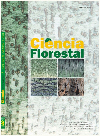
|
Ciência Florestal
Centro de Pesquisas Florestais - CEPEF, Departamento de Ciências Florestais - DCFL, Programa de Pós Graduação em Engenharia Florestal - PPGEF
ISSN: 0103-9954
EISSN: 0103-9954
Vol. 24, No. 3, 2014, pp. 699-706
|
 Bioline Code: cf14067
Bioline Code: cf14067
Full paper language: Portuguese
Document type: Note
Document available free of charge
|
|
|
Ciência Florestal, Vol. 24, No. 3, 2014, pp. 699-706
| en |
CHARACTERIZATION OF THE UNDERSTORY FUEL IN ‘SERRA DE ITABAIANA’ NATIONAL PARK – SERGIPE STATE, BRAZIL
White, Benjamin Leonardo Alves; de Souza Ribeiro, Adauto; White, Larissa Alves Secundo & Ribeiro, Genésio Tâmara
Abstract
The National Park ‘Serra de Itabaiana’, as well as other conservation units in Brazil, has commonly suffered
ecological losses caused by the wildfires. It is essential to comprehend the characteristics of the fuel to a
better understanding of a forest fire behavior and how to extinguish it. In order to do so, 108 plots of 1m2
were delimitated and all of the surface fuel was collected and weighed. The samples were then removed and
placed in an oven to determine the moisture content and the dry weight. It was collected, in the study area,
a total of 91.38 kg of dry biomass, corresponding to 8.46t/ha. Considering each vegetation type, the Grass
Fields had an average of 3.7t/ha of fuel load, the Forests 12.5t/ha and the White Sands 9.18t/ha. The results
suggest that the fuel in white sand areas can ignite more easily; there is greater difficulty of fire ignition in
forest areas; and short-lived fires in grass fields.
Keywords
forest fire; fire behavior; conservation units
|
| |
| pt |
CARACTERIZAÇÃO DO MATERIAL COMBUSTÍVEL SUPERFICIAL NO PARQUE NACIONAL SERRA DE ITABAIANA – SERGIPE, BRASIL
White, Benjamin Leonardo Alves; de Souza Ribeiro, Adauto; White, Larissa Alves Secundo & Ribeiro, Genésio Tâmara
Resumo
O Parque Nacional Serra de Itabaiana, assim como diversas outras unidades de conservação no Brasil,
comumente sofrem perdas ecológicas em função dos incêndios que os atingem. Sendo assim, torna-se
essencial compreender as características do material combustível para um melhor entendimento do
comportamento do fogo e como melhor combatê-lo. Para tal, foram demarcadas 108 parcelas de 1 m2 onde
todo o material combustível superficial foi coletado e pesado. Subamostras foram retiradas e colocadas na
estufa para determinar o teor de umidade e o peso da matéria seca. No total, foram coletados, dentro da
área de estudo, 91,38 kg de biomassa seca, correspondente a 8,46 t/ha. Considerando cada fitofisionomia
individualmente, os Campos Graminosos apresentaram uma média de 3,7 t/ha de material combustível, as
Matas 12,5 t/ha e as Areias Brancas 9,18 t/ha. Os resultados obtidos sugerem maior facilidade de ignição
do material combustível nas áreas de Areias Brancas; maior dificuldade de ignição nas áreas de Matas; e
incêndios de curta duração nas áreas de Campos Graminosos.
Palavras-chave
incêndios florestais; comportamento do fogo; unidades de conservação
|
| |
© Copyright 2014 - Ciência Florestal
Alternative site location: http://cascavel.ufsm.br/revistas/ojs-2.2.2/index.php/cienciaflorestal/index
|
|
